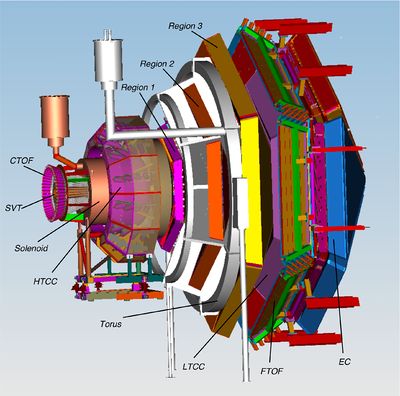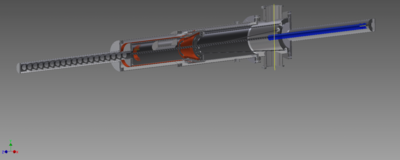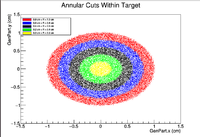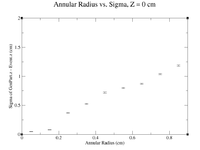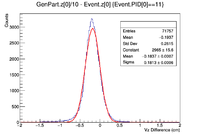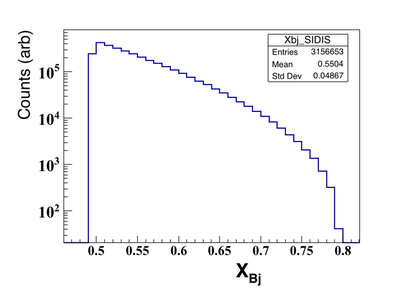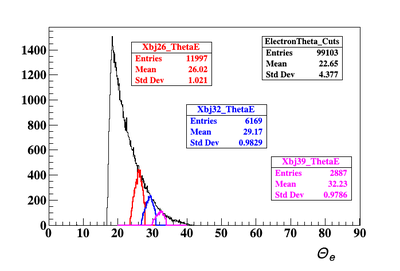Difference between revisions of "2015 NSF Proposal"
| Line 22: | Line 22: | ||
Since constructing the R1 drift chambers for the CLAS12 upgrade, the group has been preparing for upcoming experiments by focusing on simulations to optimize run conditions. A program to optimize CLAS12's ability to detect pions is currently underway. Three elements under investigation seek to quantify the moller electron background for beam pipe shielding, determine the expected vertex resolution for scattering from an extended target, and predict the detectors efficiency for detecting semi-inclusive pion scattering events. | Since constructing the R1 drift chambers for the CLAS12 upgrade, the group has been preparing for upcoming experiments by focusing on simulations to optimize run conditions. A program to optimize CLAS12's ability to detect pions is currently underway. Three elements under investigation seek to quantify the moller electron background for beam pipe shielding, determine the expected vertex resolution for scattering from an extended target, and predict the detectors efficiency for detecting semi-inclusive pion scattering events. | ||
| + | [[File:2DTargAnnularCuts.png|200px]] | ||
| + | |||
| + | [[File:AnnularRad vs Sigma z=0.png|200px]] | ||
Revision as of 23:59, 19 June 2017
Proposal Due
November 13, 2015
http://www.nsf.gov/pubs/2015/nsf15579/nsf15579.htm
000416256
Mention how construction of R1 illustrates the groups level of investment in Hall B's physics research program. The group's involvement will continue by training students in the calibration
of the CLAS12 drift chambers. Olga Cortez has already been contributing in this manner.
Annual Project Report
June 2017
Since constructing the R1 drift chambers for the CLAS12 upgrade, the group has been preparing for upcoming experiments by focusing on simulations to optimize run conditions. A program to optimize CLAS12's ability to detect pions is currently underway. Three elements under investigation seek to quantify the moller electron background for beam pipe shielding, determine the expected vertex resolution for scattering from an extended target, and predict the detectors efficiency for detecting semi-inclusive pion scattering events.
Simulations for upcoming Run Group C experiment in Hall B. Moller background simulation to evaluate beam line shielding design.
Below is the Xbj distribution predicted by clasDIS using an 11 GeV beam and a deuteron target after running two hours at full luminosity. These simulated events will be used to predict the reconstruction efficiency of the CLAS12 detector as an input to optimize the running conditions for the polarized proton and deuteron targets.
Extra material not included int he report
Below is the electron scattering angle predicted by clasDIS using a 5 GeV beam to benchmark the simulation to experiment E00-108. The distribution for several Xbj bins used in E00-108 are shown.
Publications:
P. Bosted et al. (CLAS Collaboration), "Target and Beam-Target Spin Asymmetries in Exclusive Pion Electroproduction for Q2 > 1 GeV2. II. ep → eπ0p", Phys. Rev. C 95, 035207 (2017).
M. Mayer et al. (CLAS Collaboration), "Beam-Target Double Spin Asymmetry in Quasi-Elastic Electron Scattering off the Deuteron with CLAS", Phys. Rev. C 95, 024005 (2017).
A. Kim et al. (CLAS Collaboration), "Target and Double Spin Asymmetries of Deeply Virtual π0 Production with a Longitudinally Polarized Proton Target at CLAS", Phys. Lett. B 768, 168 (2017). (
P. Bosted et al. (CLAS Collaboration), "Target and Beam-Target Spin Asymmetries in Exclusive π+ and π- Electroproduction with 1.6 to 5.7 GeV Electrons", Phys. Rev. C 94, 055201 (2016). ( Paper)
X. Zheng et al. (CLAS Collaboration), "Measurement of Target and Double-Spin Asymmetries for the ep → eπ+(n) Reaction in the Nucleon Resonance Region at Low Q2", Phys. Rev. C 94, 045206 (2016). (Paper)
